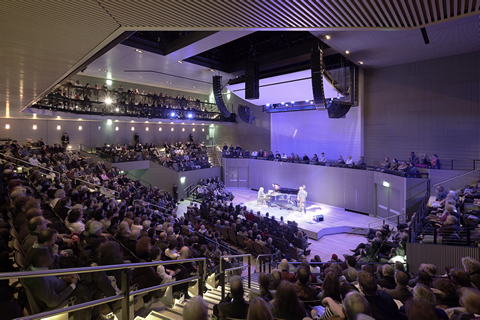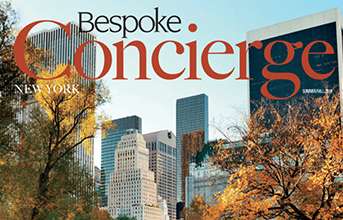SFJazz celebrates a successful first year in its new venue, the nation’s first-ever stand-alone space for jazz music.
By Monica Poling

The lights have dimmed in the Joe Henderson Lab, an 80-seat performance space in San Francisco’s SFJazz Center. As guests sip artisanal cocktails, waiting in anticipation for the show to begin, passersby on Franklin Street peek through the venue’s floor-to-ceiling glass windows to survey the action inside.
Jason Moran, one of the center’s resident artistic directors, takes the stage accompanied by the rest of his quartet, the Bandwagon. It quickly becomes clear that this is no ordinary jazz performance, however, as the group is joined by a handful of San Francisco’s top skateboarding superstars. The band and the skaters improvise together for the next 90 minutes, with the athletes coasting on a half-pipe ramp that was constructed specifically for the venue. For Moran, who staged the multimedia performance for the first time in May 2013, jazz, skateboarding and San Francisco are three artistic influences that just seem to go hand in hand.
“On one vacation, my parents brought my brothers and me to San Francisco,” he recalls. “We all brought our skateboards and were excited to [be] in the mecca of skating. As I grew older and got infatuated with jazz piano, I kept seeing signs that skating, much like jazz, was an improviser’s game.”
According to Moran, some of history’s greatest skate films—including Spike Jonze’s legendary “Video Days”—are backed by jazz soundtracks, which demonstrates the fluidity of such a collaborative relationship.
Much like Moran and the skateboarding community in general, jazz as a genre isn’t traditionally known for following the rules. On the contrary, jazz music is typically boundary-pushingn and unexpected—much like the work of SFJazz, one of the most refreshingly original arts organizations to take root in metropolitan San Francisco in decades.
Chord Progression
The center, which opened in January 2013 in San Francisco’s Hayes Valley neighborhood, is billed as the nation’s only free-standing building dedicated strictly to the performance of jazz music.
“There’s jazz at Lincoln Center [in New York], of course,” says Randall Kline, founder and executive/artistic director of SFJazz. “But that’s housed in an urban, multi-use center.”
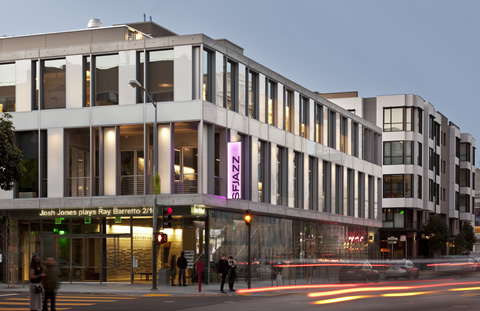
Long before the idea of a permanent home for SFJazz took hold, Kline was already firmly entrenched in the city’s underground jazz scene. In 1983, he launched a two-concert jazz festival, then simply known as Jazz in the City. Although the inaugural event couldn’t necessarily be described as a blazing success, the community supported the idea of a jazz-centric festival, so Kline began to plan year two. The festival grew, eventually morphing into what’s now known as the San Francisco Jazz Festival.
By 1999, Kline had established SFJazz, the organization that continues to oversee the festival’s planning and programming and also produces a significantly expanded, year-round calendar of events. Today, SFJazz bills itself as one of only two major organizations in the country dedicated to cultivating jazz as a living art form throughout the year.
After establishing the organization’s calendar, Kline began leading conversations about the need to build a permanent structure to showcase the performances. Nearly 30 years after the first Jazz in the City festival, the 35,000-square-foot SFJazz Center opened to widespread acclaim.
Award-winning local architect Mark Cavagnero sustainably designed the $64-million facility and, less than a year after its debut, the center announced that it had been awarded the coveted gold-level certification from LEED.
“From the beginning, we wanted a building that was green,” Kline explains. “We were shooting for a silver certification, but we ended up with the gold.”
Courtesy of its liberal use of floor-to-ceiling glass, the three-story center appears nearly transparent from the outside, encouraging pedestrians to peer inside and connect with the facility. It’s home to two performance spaces: the more intimate Joe Henderson Lab and the centerpiece Robert N. Miner Auditorium, which features flexible seating that can accommodate between 350 and 700 guests. Additional spaces include rehearsal halls, a digital learning lab, a retail shop, a box office and South at SFJazz, a bar and cafe helmed by notable San Francisco restaurateur Charles Phan.

Rising Crescendo
Ask Kline what the highlight of the past year was, and he’ll be hard-pressed to pick just one moment. “We’ve had some amazing things happen in the first year,” he comments. Although he doesn’t explicitly say so, it’s apparent that he has a particular fondness for the Joe Henderson Lab—and for good reason.
“Audiences love the intimacy of the room,” he explains. “It has the focus of a concert hall and the intimacy of a club. The listening experience, to my sometimes-jaded ears, is as good as it can get. There isn’t another room in the world that I’d rather listen to music in.”
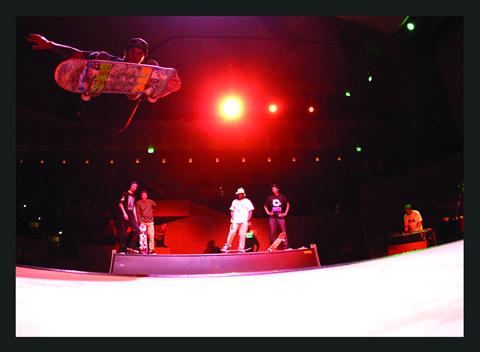
But the larger Miner Auditorium, which in its first year has witnessed performances from blockbuster entertainers including legendary trumpeter Wynton Marsalis, pianist Herbie Hancock, saxophonist and composer Wayne Shorter and vocalist Dianne Reeves, has also played host to many of his favorite moments. “It was one of the most beautiful Dianne Reeves concerts I’ve ever heard,” Kline says of the singer’s May 2013 stop at the center.
Another highlight for Kline was a performance designed by guitarist Bill Frisell, one of Moran’s fellow resident artistic directors. “Bill Frisell wrote a score for a 10-piece small orchestra, which was performed along with the text to ‘The Kentucky Derby is Decadent and Depraved’ by Hunter S. Thompson,” Kline adds.
Thompson’s 1970 essay, now considered a journalistic classic, was the result of his assignment from the now-defunct publication Scanlan’s Monthly to report on the Kentucky Derby; the result, his first piece of “gonzo” journalism, was an article that focused less on the sporting event and more on the rampant debauchery that surrounded it. In lieu of a photographer, he attended the event with British illustrator Ralph Steadman—the first of many collaborative efforts between the two men.
Frisell arranged a score to accompany Thompson’s piece, and the work was presented in the style of an old-time radio broadcast. Academy Award-winning actor Tim Robbins, who served as narrator, joined a cast of notable musicians to bring the composition to life.
While performances throughout the first 18 months of the SFJazz Center’s history have been illustrious and distinctive, jazz education is also a cornerstone of the center, which features a varied series of programs designed for both children and adults.
The SFJazz High School All-Stars program, for example, creates performance opportunities for up-and-coming musicians. Selected annually through competitive auditions, participants rehearse and perform with some of today’s top jazz educators and artists. “They just won a national competition,” Kline says of the students. “They are the top band in the country.”
The program helps open a number of doors for the talented students, who typically continue their training at high-ranking universities and other institutions. “Most of those kids go to the top conservatories in the country,” he adds.
A range of other educational programs are also available, including the Koret Discover Jazz series, a jazz appreciation course for adults; master classes for aspiring musicians; and the SFJazz World Drum Week in August, an event that encourages families to play drums alongside master jazz percussionists.
To be Composed
When glancing at the 2014 summer schedule, it becomes immediately apparent that at the SFJazz Center, the concept of “jazz” has a broad definition. “We don’t have a strong dogmatic view of one aspect of jazz,” Kline agrees.
The center recently completed its first annual SFJazz Poetry Festival featuring Ishmael Reed, the organization’s resident poet laureate, who organized a group of poets to recite their works alongside improvising instrumentalists.
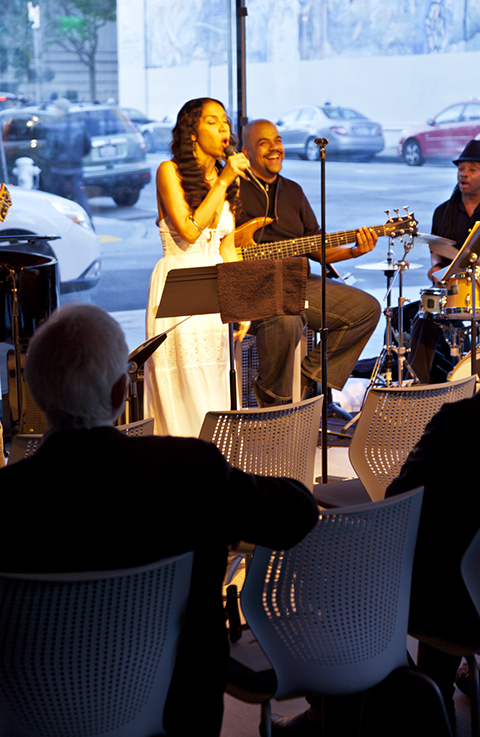
Other summer events include the return of the San Francisco Jazz Festival, now in its 32nd year, with performances by four-time Grammy Award-winner Dianne Reeves as well as jazz guitarist John Scofield, who joins the jazz-funk trio Medeski Martin & Wood.
Also liberally represented at the festival are local performers, including the Bay Area’s Pacific Mambo Orchestra, which took home the trophy for Best Tropical Latin Album at the 2014 Grammy Awards, and saxophonist Sheldon Brown and his 10-piece backing orchestra.
International performers include Seun Kuti, the son of celebrated Nigerian musician Fela Kuti, and his band, Egypt 80, as well as Ester Rada, who presents a cross-cultural Ethio-jazz, reggae and classic funk performance that reflects her Ethiopian heritage and Israeli upbringing.
The second annual Summer Sessions series, which begins July 17 and runs through Aug. 24, also presents a staggering assortment of jazz performances. One of this summer’s themes, Great America’s Songbook, is staged in three installments to celebrate popular music of the Americas, from country blues, gospel, folk and the swinging sounds of New Orleans to the soulful tunes of Cuba and Brazil.
In August, the lively Dance to the Music series spotlights C.J. Chenier and the Red Hot Louisiana Band as they stage a Creole dance party in the Miner Auditorium. Lavay Smith & Her Red Hot Skillet Lickers, meanwhile, performs a tribute to New York City’s legendary Savoy Ballroom of the 1930s.
The summer season concludes with the Festival of the Trumpet, which showcases world-renowned jazz trumpet performers. including acclaimed bandleader Sean Jones, a former Jazz at Lincoln Center trumpeter. The festival ends with a performance by award-winning showman Doc Severinsen, who led the in-house band for “The Tonight Show” for 25 years.
Acts alternate between the Joe Henderson Lab and the Miner Auditorium, which has been named by critics as one of the most impressive performance spaces in all of San Francisco—and the country—in terms of sound and sightlines. The accolades and public praise haven’t gone unheard by Kline, but he still maintains that the SFJazz Center is first and foremost a space for artists rather than audiences.
“We built this because we feel strongly about this art form and wanted a place where artists can express it to its fullest,” he explains.
“[This] venue is an amazing testament to the power of community and the power of music,” Moran adds, expressing his profound appreciation of the powerhouse performance space. For Moran, at least, SFJazz got it right.
***
Musicians in Residency
In addition to its star-studded lineup of concerts and educational events, SFJazz also nurtures its own talent in the form of the SFJazz Collective, an award-winning jazz ensemble that includes eight of the leading jazz performers and composers at work today.
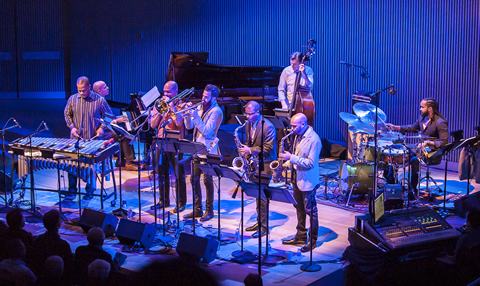
Each year, the ensemble performs original compositions and debuts reworked arrangements of pieces composed by modern jazz masters, including Herbie Hancock, Thelonious Monk, Wayne Shorter, McCoy Tyner, Horace Silver, Stevie Wonder and Chick Corea.
The group meets in San Francisco every spring for a multiweek residency, during which it develops compositions for the year while also presenting jazz education programs for area youth and adults.
This year, the SFJazz Collective toasted its 10th anniversary with a spring tour that presented retrospective performances of the group’s best works from the past decade, and in August, the ensemble appears at the 60th annual Newport Jazz Festival in Rhode Island.

